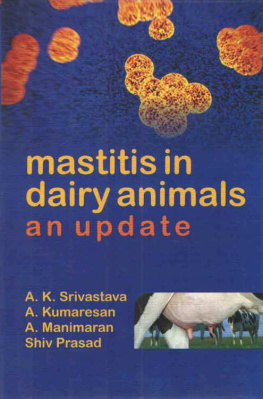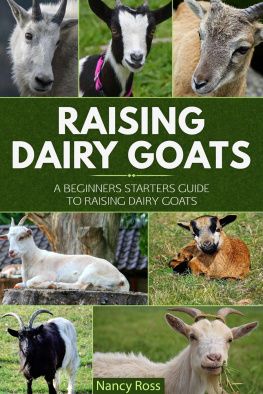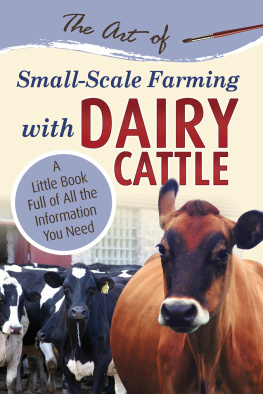Srivastava - Mastitis in dairy animals : an update
Here you can read online Srivastava - Mastitis in dairy animals : an update full text of the book (entire story) in english for free. Download pdf and epub, get meaning, cover and reviews about this ebook. year: 2015, publisher: Satish Serial Publishing House,Mint Associates Ltd, genre: Home and family. Description of the work, (preface) as well as reviews are available. Best literature library LitArk.com created for fans of good reading and offers a wide selection of genres:
Romance novel
Science fiction
Adventure
Detective
Science
History
Home and family
Prose
Art
Politics
Computer
Non-fiction
Religion
Business
Children
Humor
Choose a favorite category and find really read worthwhile books. Enjoy immersion in the world of imagination, feel the emotions of the characters or learn something new for yourself, make an fascinating discovery.
- Book:Mastitis in dairy animals : an update
- Author:
- Publisher:Satish Serial Publishing House,Mint Associates Ltd
- Genre:
- Year:2015
- Rating:4 / 5
- Favourites:Add to favourites
- Your mark:
- 80
- 1
- 2
- 3
- 4
- 5
Mastitis in dairy animals : an update: summary, description and annotation
We offer to read an annotation, description, summary or preface (depends on what the author of the book "Mastitis in dairy animals : an update" wrote himself). If you haven't found the necessary information about the book — write in the comments, we will try to find it.
Mastitis in dairy animals : an update — read online for free the complete book (whole text) full work
Below is the text of the book, divided by pages. System saving the place of the last page read, allows you to conveniently read the book "Mastitis in dairy animals : an update" online for free, without having to search again every time where you left off. Put a bookmark, and you can go to the page where you finished reading at any time.
Font size:
Interval:
Bookmark:
The authors are thankful to Nitin M Attupuram, Sreela L, S. S. Layek, Ms. Shivani Chhillar, Ms. Samiksha, Ms. Satya, K, S. K. Rajak, M. Arul Prakash and Raushan Kumar Singh for their help in formatting and proof reading of the book.
Mastitis in Dairy Animal: Current Concepts & Future Concerns
India ranks first in milk production by producing around 17% of total world's milk production. Although the consumption of milk is heterogeneous over the world and varies among the different countries, the European Union and North America continue to be the largest milk consumers. In developing countries also demand for the dairy products has grown considerably, especially in China, India and several Asian countries. Taken together the increasing demand for milk and milk products, across the globe and to fulfill the increasing domestic requirements, the milk production needs to be increased. In India, milk production has registered impressive growth during the postindependence era, which has jumped from 17 million tonnes in 1950- 51 to 132.4 million tonnes in 2012-13. Increase in milk production boosted the per capita availability of milk to the population of the country. In 1950-51, the per capita milk availability was only 130 gram per day and today the national average is above the ICMR recommended level of 280 gram per day and is expected to reach 290 gram per day in 2013. In 2011-12, the rate of growth in milk production was also substantially higher (5%) than the world average of 1.5 per cent. The milk production and per capita availability over last few decades are given in figure 1.1. However, the demand of milk and milk products in India is projected to increase to 142.9 million tonnes by 2015 and further to 191.3 million tonnes by 2020 [1]. At the existing rate of growth in milk production, in next ten years, supply is likely to fall short of the demand. Among the several barriers in achieving the milk production targets, mastitis continues to remain as a most challenging impediment, since the affected quarters show 30% less productivity and cow looses about 15% production.
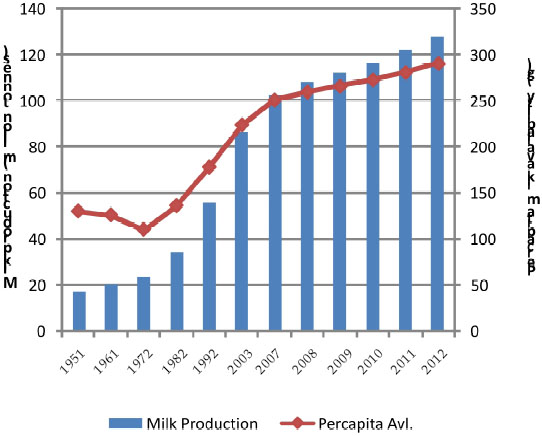
Fig. 1.1 : Milk production and percapita milk availability in India
Mastitis, the inflammation of parenchyma of mammary glands, is a complex multi-etiological disease affecting dairy cattle worldwide. Based on the severity, the inflammation can be classified into sub- clinical, clinical and chronic forms, and its degree is dependent on the nature of causative pathogen and on the age, breed, immunological health and lactation state of the animal. Mastitis is characterized by physical, chemical and usually bacteriological changes in milk and pathological changes in glandular tissues affecting milk production and its quality.
The mammary gland, because of its anatomical position, is exposed to several external factors that influence the physiology and pathology of the mammary parenchyma. Several microbial species, when enter into the udder, have the ability to infect the mammary parenchyma resulting in mastitis. Generally the udder defense mechanism clears off the infection, but when the animal is under immune-suppression (especially during immediate post-partum period), the organism gets upper hand resulting in mastitis. Thus, occurrence of mastitis is an outcome of the interplay between the infectious agents and management practices stressing the defense of udder. Poor milking hygiene, milking machine faults, teat injuries and populations of pathogens on the cow's skin and epithelia and in its environment predisposes the cow to mastitis. In spite of consistent efforts by the researchers on mastitis causing organisms and its various aspects of treatment and control, the problem of mastitis remains insurmountable to the dairy farmers and poses several challenges to modern veterinary practioners. A better understanding of the multiplicity of pathogens causing mastitis, knowledge of mammary gland immunology, bacterial virulence factors and mechanism of pathogens would help in developing effective preventive and therapeutic strategies, which would result in reduced severity of mastitis, increased production and profitability, and ensure supply of safe and nutritious milk and milk products to the consumers.
Mastitis, on account of causing serious wastage and undesirable milk quality, has emerged as a major challenge and continue to be one of the most common and costly diseases in dairy cattle across the globe accounting for around 40% of the total direct costs of the common production diseases [2].
The world's milk production has reached 711 million tonnes in 2010 from 547 million tonnes in 1996 and is expected to rise above 794 million tonnes in 2017. With an output of 257 million tonnes, Asia remains the region with both the largest production and the highest rate of annual growth in 2010. However, with the increase in milk production, the production diseases especially mastitis is also increased. In India, the economic losses due to mastitis have increased about 115 folds in last five decades [3]. Surveys on the prevalence of mastitis in most countries, irrespective of the cause, show a comparable figure of 50% among dairy cows. Subclinical mastitis is believed to be more prevalent than clinical mastitis in most countries. Globally, the prevalence of subclinical mastitis on farms could range from 19 to 78% as indicated in figure 1.2.
After analyzing the published reports, one can safely say that the average prevalence of mastitis in 1960s to early 1990s, was not more than 30 per cent, however afterwards the prevalence increased to even more than 60 per cent (Fig. 1.3). Two decades ago the average incidence of clinical mastitis in India was 1-10% with subclinical mastitis ranging from 10-50% in cows and 5-20% in buffaloes, while recent studies reported high incidence of subclinical mastitis ranging from 20 to 83 per cent in cows and 45 per cent in buffaloes. Analyzing data reported by more than 100 recent studies spread over 21 states of India indicate that the overall prevalence of mastitis ranges from 25 to 97 per cent with an average prevalence of about 50 per cent [5]. This clearly indicates drastic increase in the prevalence of mastitis especially the subclinical form of the disease, which is an alarming situation to the dairy sector in the country.
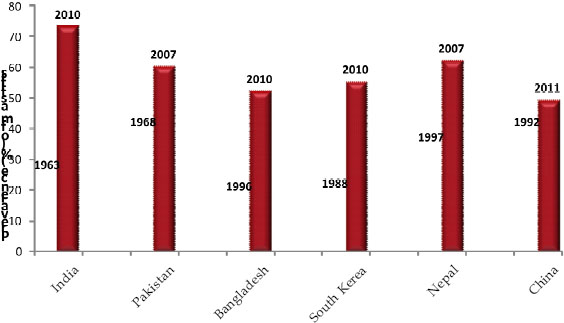
Fig. 1.2 : Prevalence of mastitis in Asian countries [3]

Fig. 1.3: Increasing trend of mastitis prevalence in dairy animals [3]
In mastitis, the loss is due to temporary or permanent loss of milk production, poor milk quality, discarding of milk after antibiotic treatment and pre-mature culling or reduced productive life of animals. The loss due to subclinical mastitis overweighs the loss associated with clinical mastitis. In the affected animals, the milk yield is reduced considerably. Different workers estimates of milk yield loss range from 100 to 500 kg/cow per lactation. When Clinical Mastitis occurs, additional costs result from discard of abnormal milk, drugs, and veterinary services.
According to a study, the estimated loss following clinical mastitis was almost 700 kg for cows in first lactation and 1,200 kg for cows in second or higher lactation [6]. Each case of clinical mastitis has been estimated to cost between $100 and $200 per cow within the lactation. A Sweden based study reported the average cost of clinical and subclinical mastitis to be 275 and 60 per case, respectively [7]. Globally, losses due to mastitis are estimated at about US$ 35 billion annually. The disease accounts for an overall annual loss of about 1.55 billion in European Union [8]. In the United States of America, National Animal Health Monitoring Survey indicated that mastitis is the most prevalent disease affecting adult dairy cows and costs the American dairy producers approximately $2 billion each year, which is approximately 10 percent of the total value of farm milk sales [9, 10]. Other major milk producing countries also suffer huge financial losses due to mastitis. As per the recently reviewed information, Australian and New Zealand dairy sector lost annually US$ 200 million and US$141.70 million, respectively due to poor udder health [11]. The Brazilian dairy farmers suffer an economic loss of approximately one billion reas (BRL) annually [12]. In India, annual economic losses incurred by dairy industry on account of udder infections have been estimated about Rs. 6053.21 crore. Out of this, loss of Rs. 4365.32 crore (70 - 80 %) has been attributed to sub-clinical version of udder infections [13]. In another report from India, the annual economic losses due to mastitis, has been calculated to be approximately Rs. 7165.51 crores; losses being almost same for cows (3649.56 crores) and buffaloes (3515.95 crores). Subclinical mastitis has been estimated to account for 57.93% (4151.16 crores) of the total economic loss due to mastitis [14]. In another report, it has been estimated thatthe estimated loss due to mastitis is around Rs 16,702 million per annum [15].
Font size:
Interval:
Bookmark:
Similar books «Mastitis in dairy animals : an update»
Look at similar books to Mastitis in dairy animals : an update. We have selected literature similar in name and meaning in the hope of providing readers with more options to find new, interesting, not yet read works.
Discussion, reviews of the book Mastitis in dairy animals : an update and just readers' own opinions. Leave your comments, write what you think about the work, its meaning or the main characters. Specify what exactly you liked and what you didn't like, and why you think so.

